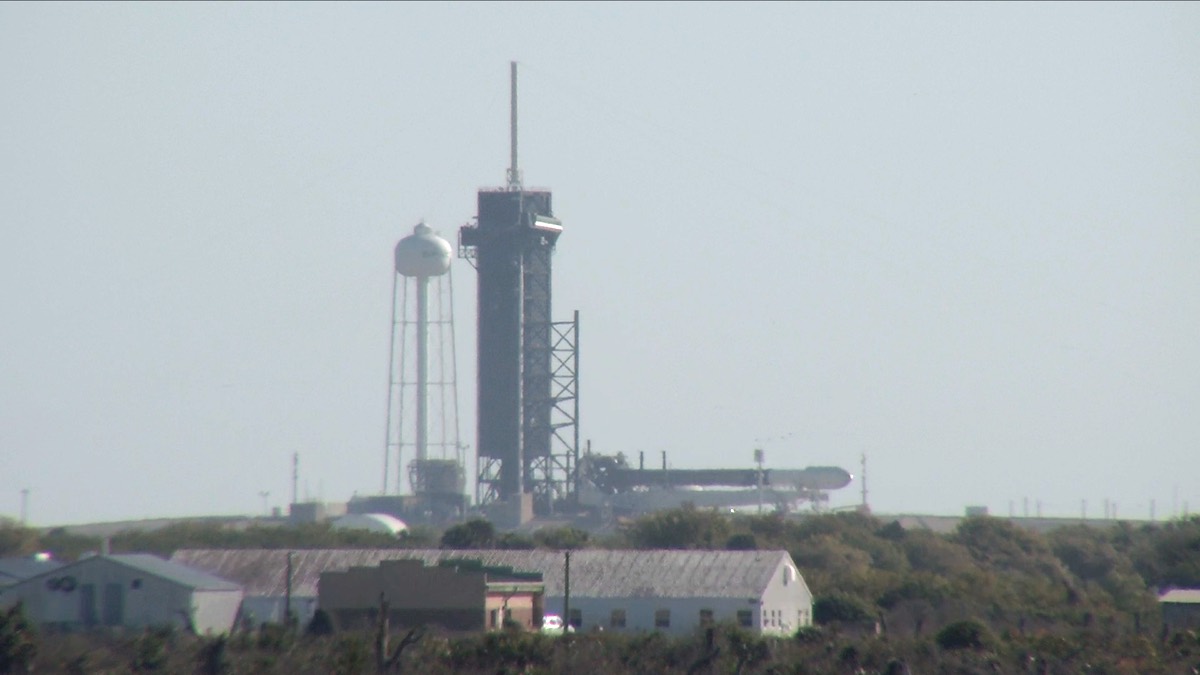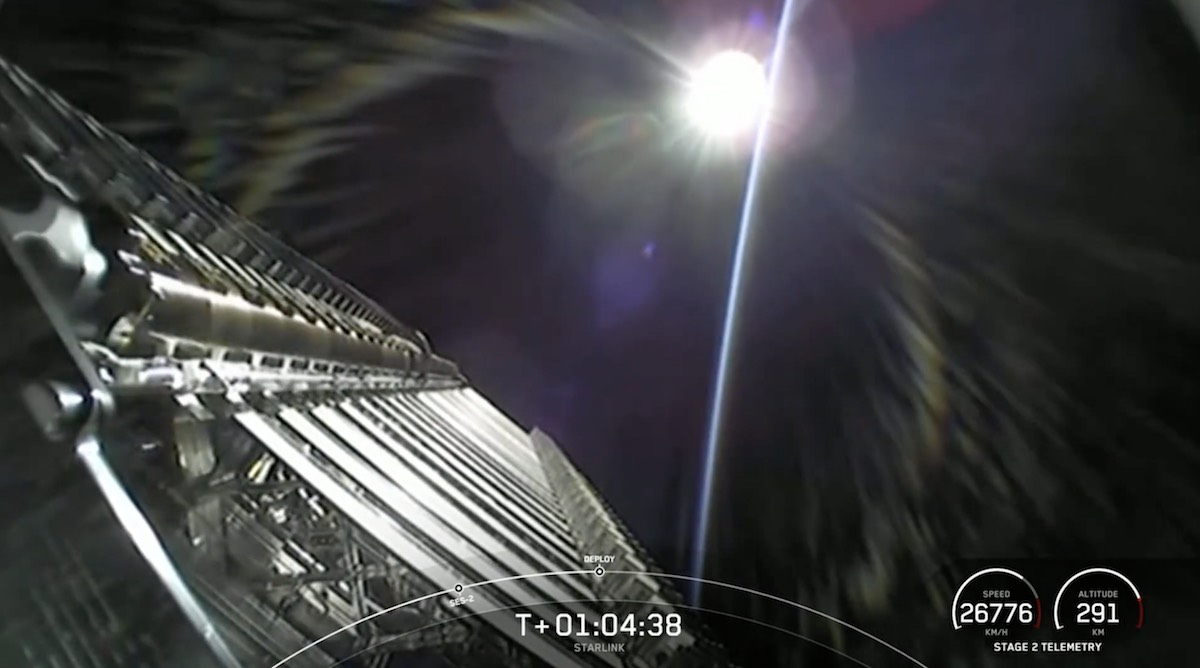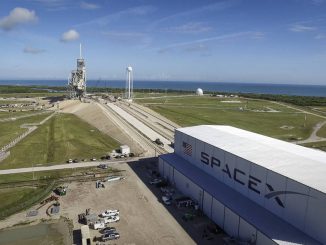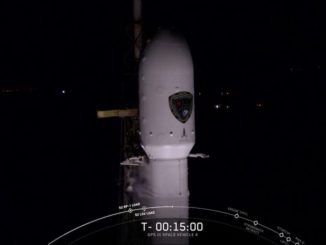EDITOR’S NOTE: Launch of SpaceX’s next mission is scheduled for 6:01 a.m. EDT (1001 GMT) Sunday. Daylight saving time begins in the United States at 2 a.m. local time Sunday.

For the third time in 10 days, SpaceX is readying a Falcon 9 rocket for launch Sunday from Florida’s Space Coast with another 60 Starlink internet satellites. This time, SpaceX aims to extend the record for reusing a Falcon 9 booster to nine flights.
The launch of SpaceX’s next 60 Starlink satellites is scheduled for an instantaneous opportunity at 6:01 a.m. EDT (1001 GMT) Sunday from pad 39A at NASA’s Kennedy Space Center in Florida.
The mission will be SpaceX’s eighth Falcon 9 launch of the year, and the third in 10 days from two Florida launch pads a few miles apart. The two previous Falcon 9 flights March 4 and March 11 each carried 60 Starlink satellites into orbit.
SpaceX transferred the Falcon 9 rocket for Sunday’s launch to pad 39A early Saturday, rolling the 229-foot (70-meter) rocket the quarter-mile distance from an integration hangar on the southern perimeter of the historic launch complex, once used as the departure point for Apollo moon missions and numerous space shuttle flights.
Ground crews were expected to lift the rocket vertical later Saturday to prepare for the predawn countdown Sunday, when SpaceX teams will oversee loading of the two-stage launcher with kerosene and liquid oxygen propellants.
There is a 90% chance of favorable weather for liftoff Sunday morning, according to the U.S. Space Force’s 45th Weather Squadron.
The Falcon 9 rocket set for launch Sunday will fly with a first stage booster recovered from eight prior missions. The booster — designated B1051 — will be the first in SpaceX’s inventory to launch for a ninth time. Two different first stages in SpaceX’s fleet, including B1051, are currently tied for the record with eight missions.
The rocket’s payload fairing, or nose cone, is also refurbished from a previous mission. The shroud launched on a Falcon 9 mission in January, and SpaceX recovery ships retrieved the fairing from the Atlantic Ocean.
SpaceX officials have said the most recent version of the Falcon 9 booster can make 10 flights with only inspections and minor refurbishment in between missions. With an overhaul, the Falcon 9 Block 5 boosters could fly 100 missions, SpaceX founder and CEO Elon Musk has said.
Hans Koenigsmann, a senior advisor and former vice president at SpaceX, said last month he believes the 10-flight limit is not a “magic number.”
“We’ve learned a lot about refurbishment,” he said during a Feb. 23 panel discussion at the 47th Spaceport Summit. “We’re learning … what to pay attention to and maybe some of these are obvious. We want to take care of the heat shield. There are some engine components that need, on a regular basis, a degree of inspection to make sure the seals are working, and so on and so forth. So we’ve been learning with every single landing.”
The Starlink network is driving SpaceX’s high tempo launch cadence. Koenigsmann said SpaceX will soon reach the 10-flight mark with one of its Falcon 9 boosters.
“I’m pretty sure we will get to 10 flights soon, and then we will continue to look at the booster and make an assessment (whether) we can move forward with it,” he said. “My personal opinion is that we will probably continue until we see more damage on the booster.”
Koenigsmann said SpaceX will look at data rather than specifying a certain number of flights for each booster.
“We will inspect them regularly, at regular intervals” he said. “And the next time you check that the engine held up and see if there’s any damage there. To me, it is an engineering problem. I don’t think the number of 10 is a magic number.
“Also, for example, we could start phasing in new components at some point in time and actually extend the life of the booster,” Koenigsmann said.

SpaceX has launched 1,265 Starlink internet satellites to date. Some of those satellites were prototypes and have re-entered the atmosphere and burned up. Jonathan McDowell, an astronomer at the Harvard-Smithsonian Center for Astrophysics and a respected tracker of spaceflight activity, says SpaceX currently has about 1,200 Starlink satellites in orbit.
The launch Sunday will be SpaceX’s 22nd dedicated Falcon 9 mission with Starlink satellites.
The Starlink network could eventually number more than 10,000 satellites, but the first tranche of Starlinks will have 1,584 satellites orbiting 341 miles (550 kilometers) above Earth on paths tilted 53 degrees to the equator. SpaceX has approval from the Federal Communications Commission for around 12,000 Starlink satellites at a range of altitudes and inclinations, all within a few hundred miles of the planet. The low altitude enables the satellites to deliver high-speed, low-latency connectivity to customers, and helps ensure the spacecraft naturally re-enter the atmosphere faster than if they flew farther from Earth.
Starlink is already providing interim beta service across high latitude regions, such as the northern United States, Canada, and England. More Starlink launches this year will enable an expanded coverage area.
SpaceX announced earlier his week that the Starlink beta service will soon begin reaching customers in Germany, New Zealand, and in other regions of the United Kingdom, including Wales, Scotland, Northern Ireland, and northern England. Those areas could receive beta service in the “coming weeks,” SpaceX said.
SpaceX is accepting pre-orders from would-be Starlink consumers, who can pay $99 to reserve their place in line to get Starlink service when it becomes available in their area. For people in the southern United States and other lower-latitude regions, that should come by late 2021, SpaceX says.
Once confirmed, customers will pay $499 for a Starlink antenna and modem, plus $50 in shipping and handling, SpaceX says. A subscription will run $99 per month.
The Starlink satellites are built by SpaceX in Redmond, Washington, and each spacecraft weighs about a quarter-ton at liftoff. They are fitted with power-generating solar array wings, krypton ion thrusters for propulsion, and visors to dim their brightness to people on the ground, a mitigation added to Starlink satellites last year after astronomers raised concerns the spacecraft would ruin some telescopic observations.
Like previous Starlink launches, the satellites will separate from their Falcon 9 launcher Sunday in a lower-altitude transfer orbit, then use their ion thrusters to move higher into the operational Starlink fleet at 341 miles high.
The Falcon 9’s first stage will aim to land on SpaceX’s drone ship “Of Course I Still Love You” in the Atlantic Ocean northeast of Cape Canaveral about eight-and-a-half minutes after liftoff. The drone ship will bring the veteran rocket back to Florida for preparations for a potential 10th launch.
The rocket’s upper stage, meanwhile, will guide the 60 Starlink satellites into an orbit with an average altitude of roughly 168 miles (271 kilometers) using two engine burns. Deployment of the 60 flat-packed satellites is scheduled at 7:05 a.m. EDT (1105 GMT), about 64 minutes after blasting off from the Kennedy Space Center.
Email the author.
Follow Stephen Clark on Twitter: @StephenClark1.



